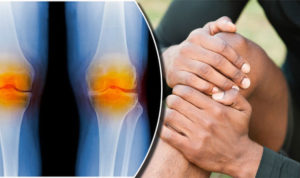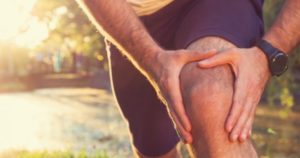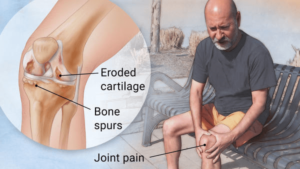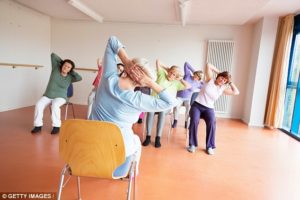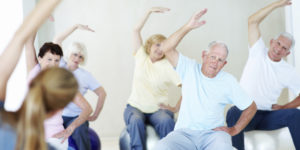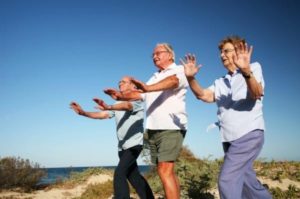Improve Knee Osteoarthritis with Tai Chi
By John M. de Castro, Ph.D.
“Experts have long recommended tai chi as a low-impact workout that’s gentle on the joints. Research . . . revealed additional benefits: It may be as effective as physical therapy for knee osteoarthritis (OA).” – Sharon Liao
Osteoarthritis is a chronic degenerative joint disease that is the most common form of arthritis. It produces pain, swelling, and stiffness of the joints. It is the leading cause of disability in the U.S., with about 43% of arthritis sufferers limited in mobility and about a third having limitations that affect their ability to perform their work. Knee osteoarthritis effects 5% of adults over 25 years of age and 12% of those over 65. It is painful and disabling. Its causes are varied including, hereditary, injury including sports injuries, repetitive stress injuries, infection, or from being overweight.
There are no cures for knee osteoarthritis. Treatments are primarily symptomatic, including weight loss, exercise, braces, pain relievers and anti-inflammatory drugs, corticosteroids, arthroscopic knee surgery, or even knee replacement. Gentle movements of the joints with exercise and physical therapy appear to be helpful in the treatment of knee osteoarthritis. This suggests that alternative and complementary practices that involve gentle knee movements may be useful in for treatment. Indeed, yoga practice has been shown to be effective in treating arthritis. Various forms of traditional Chinese exercises, such as Tai Chi, Qigong, and Baduanjin involve slow gentle movements of the limbs and mindfulness and have been shown to reduce the physical symptoms of knee osteoarthritis. So, it would seem reasonable to look further into the effectiveness of Tai Chi relative to physical therapy in treating knee osteoarthritis.
In today’s Research News article “Effects of Tai Chi versus Physical Therapy on Mindfulness in Knee Osteoarthritis.” (See summary below or view the full text of the study at: https://www.ncbi.nlm.nih.gov/pmc/articles/PMC5612617/ ), Lee and colleagues recruited adults over the age of 40 who were diagnosed with knee osteoarthritis and randomly assigned them to receive either Tai Chi for 60 minutes, twice a week, for 12 weeks, or physical therapy for knee osteoarthritis for 30 minutes twice a week for the first 6 weeks and 4 times a week for the second 6 weeks. They were measured before and after training for mindfulness, pain, stiffness, and physical function, 6-minute walk test, quality of life, depression, perceived stress, and arthritis self-efficacy.
Overall, compared to baseline the patients showed significantly reduced pain, depressive symptoms, and stress; and improved physical function, quality of life, self-efficacy, and walk distance. There were no significant differences between the groups. Hence, Tai Chi practice was found to be as effective as physical therapy in alleviating the symptoms of knee osteoarthritis.
Tai Chi practice, though has a number of advantages. It is completely safe, can be used with the elderly and sickly, is inexpensive to administer, can be performed in groups or alone, at home or in a facility or even public park, and can be quickly learned. In addition, it can also be practiced in social groups without professional supervision. This can make it fun, improving the likelihood of long-term engagement in the practice. Hence, Tai Chi would appear to be an excellent treatment for the symptoms of knee osteoarthritis.
So, improve knee osteoarthritis with Tai Chi.
“Tai chi helps improve physical strength and mobility and promotes a sense of well-being. . . participants with knee osteoarthritis who practiced tai chi twice a week had less pain and better physical function compared with study participants enrolled in a wellness education and stretching program.” – Harvard Health
CMCS – Center for Mindfulness and Contemplative Studies
This and other Contemplative Studies posts are also available on Google+ https://plus.google.com/106784388191201299496/posts and on Twitter @MindfulResearch
Study Summary
Lee, A. C., Harvey, W. F., Wong, J. B., Price, L. L., Han, X., Chung, M., Driban, J. B., Morgan, L., Morgan, N. L., … Wang, C. (2017). Effects of Tai Chi versus Physical Therapy on Mindfulness in Knee Osteoarthritis. Mindfulness, 8(5), 1195-1205.
Abstract
Tai Chi mind-body exercise is widely believed to improve mindfulness through incorporating meditative states into physical movements. A growing number of studies indicate that Tai Chi may improve health in knee osteoarthritis (OA), a chronic pain disease and a primary cause of global disability. However, little is known about the contribution of mindfulness to treatment effect of Tai Chi practice. Therefore, our purpose was to investigate the effect of Tai Chi mind-body practice compared to physical therapy (PT) on mindfulness in knee OA. Adults with radiographic-confirmed, symptomatic knee OA were randomized to either 12 weeks (twice weekly) of Tai Chi or PT. Participants completed the Five Facet Mindfulness Questionnaire (FFMQ) before and after intervention along with commonly-used patient-reported outcomes for pain, physical function, and other health-related outcomes. Among 86 participants (74% female, 48% white, mean age 60 years, 85% at least college educated), mean total FFMQ was 142±17. Despite substantial improvements in pain, function, and other health-related outcomes, each treatment group’s total FFMQ did not significantly change from baseline (Tai Chi= 0.76, 95% CI: −2.93, 4.45; PT= 1.80, 95% CI: −2.33, 5.93). The difference in total FFMQ between Tai Chi and PT was not significant (−1.04 points, 95% CI: −6.48, 4.39). Mindfulness did not change after Tai Chi or PT intervention in knee OA, which suggests that Tai Chi may not improve health in knee OA through cultivating mindfulness. Further study is needed to identify underlying mechanisms of effective mind-body interventions among people with knee OA.
https://www.ncbi.nlm.nih.gov/pmc/articles/PMC5612617/
